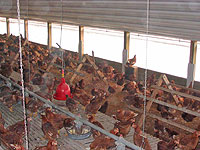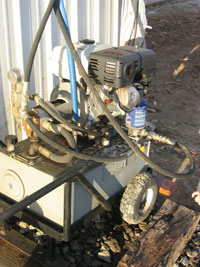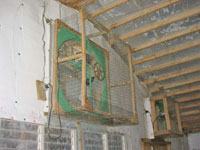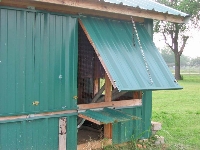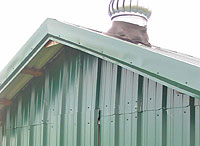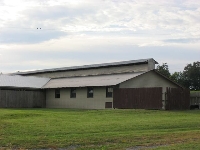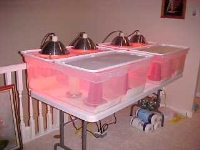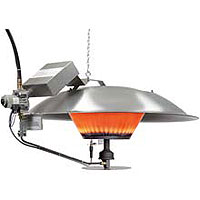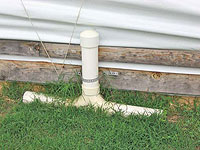skip
navigation  |
800-411-3222 (Español)
Poultry House Management for Alternative Production |
| By Anne Fanatico NCAT Agriculture Specialist Published 2007 ATTRA Publication #IP308 |
The
printable PDF version of the entire document is available
at: http://attra.ncat.org/attra-pub/PDF/poultryhousemanage.pdf 16 pages — 572K Download Acrobat Reader |
Abstract
While access to the outdoors is an important feature of many alternative or free-range production systems, the indoor environment and management are also crucial. Poultry need access to an appropriate indoor environment for good production and welfare. Ideally, poultry should choose an environment; whether to be indoors or outdoors. Attention to ventilation, temperature, lighting, and litter conditions is needed. Additional good management practices include rodent control with a minimum of toxic materials. Alternative poultry production is often on a small scale, with portable houses. Production may be certified organic. Special practices may be needed compared to conventional poultry production. Alternative poultry production is a way to boost farm income and add fertility or diversity to a farm, while providing specialty poultry products to consumers as a part of sustainable agriculture. Table of Contents
Introduction
Alternative poultry production includes systems such as cage-free and free-range, as an alternative to conventional poultry housing and cages. Free-range systems vary widely. Some may feature large, fixed houses with yards. Others may be small portable houses regularly moved to fresh pasture. Some may consist of small shelters or pens. Alternative poultry production is often small scale, integrated onto a diversified farm, and certified organic. While free-range is a main feature, environmental conditions inside the house are also important for good welfare, particularly ventilation, temperature, lighting, and litter. A lot of information is available on environmental control in conventional poultry production. This publication, however, focuses on alternative production, for which information is less available. Nonetheless, some practices apply to both alternative and conventional production. This publication provides "how-to" information about environment and management in alternative poultry production and highlights the practices of innovative producers. Many of the practices described here can be employed in organic production. For information on other production topics such as breeds, feed, health, etc., refer to other resources. For information on providing outdoor access and the outdoor area, see ATTRA's Alternative Poultry Production Systems and Outdoor Access. Alternative poultry production is an important part of sustainable agriculture, protecting the environment while addressing consumer concerns. EnvironmentPoultry housing should be weather-proof to provide protection from the elements (cold, rain, wind, and hot sun) and provide warmth, especially during brooding. Housing should also provide good ventilation, as well as protection from predators. Many innovative housing designs are used in alternative poultry production, including fixed houses with permanent foundations, mobile houses, and simple shelters. For information on small-scale housing, design, materials, construction plans, see ATTRA's Range Poultry Housing. For information on waterers, feeders, fencing, roosts, and nestboxes, see ATTRA's Poultry: Equipment for Alternative Production. The conventional poultry industry has extensive information on large-scale housing, environmental control, and equipment that can be used for large-scale free-range or cage-free production. See Commercial Chicken Production Manual (1) or Extension materials. Detailed information on ventilation, lighting, and other types of environmental control are available on the University of Georgia's (2) Poultry House Environmental Control Website at www.poultryventilation.com. Power
While small portable houses may not use power, reliable power is important in large houses to power ventilation systems, fans, lights, heat, motors for automated feeding systems, etc. Most farms have electricity, but diesel generators can be used for power in a poultry house and are also useful for backup power in case of an electrical outage. Temperature
The body temperature of an adult chicken is 105-107°F (40.6 to 41.7°C). The thermoneutral zone is 65-75°F (18-24°C), which allows chickens to maintain their body temperature. If the temperature is above this zone, heat must be lost in some way. Chickens have no sweat glands. Since eating increases body temperature, chickens reduce their feed intake during hot weather, and therefore gains will be less. Chickens begin panting at 85°F (29.4°C) to help dissipate heat, and drink more to avoid dehydration. A combination of high temperature and high humidity is a problem, because panting does not cool them under these conditions (1). In the U.S., heat is usually more of a problem than cold. Fast-growing broilers are particularly susceptible to heat stress due to their high level of production. Producers should provide abundant cool drinking water in close proximity to the birds inside and outside. In cold months, while the conventional industry usually uses propane heaters for heating, many alternative poultry producers do not heat houses, relying only on the body warmth of the birds for heat. However, birds tend to eat more in cold temperatures, because they need more energy to stay warm outside. It may be more cost effective to heat the house instead of paying for more feed. Heaters, such as gas brooders or heaters, can even be provided in small portable houses, with a gas tank mounted on a trailer to be moved along with the house. To modulate temperatures, insulation under the roof is important in any climate; insulation in the walls is also helpful. Some assurance programs in Europe require that fixed houses be insulated (3). During hot weather, insulation keeps heat from entering, and during cold weather keeps heat from leaving the building. The greater the difference between the inside temperature and the outside temperature, the greater the need for insulation. Proper ventilation will also help regulate house temperature. Each house should have a thermometer to display the current temperature as well as the high and low temperatures in a daily period, and producers should pay attention to weather forecasts. Ventilation
Ventilation brings fresh air into a poultry house and removes heat, moisture, and gases. (1) Ventilation designs may be natural or mechanical. Most houses in alternative poultry production depend on natural ventilation, because doorways are usually open to provide outdoor access. There may also be additional air inlets, side curtains, or large windows that can be opened to allow more ventilation in hot weather. Ridge vents in the roof or "whirly bird" vents allow hot air to escape. Natural ventilation makes use of the movement of air (warm air rises and cold air falls) and wind currents. A roof at least six feet tall will allow sufficient height differential for cool air to enter through low air inlets and warm air to escape through high vents. There is less control in natural ventilation than mechanical.
The reasons for ventilating during winter and summer are different. During warm months, the purpose is to remove heat and control the temperature in the house, and therefore large amounts of air are moved. During cold months, the ventilation system must remove moisture and gases, especially ammonia, while conserving heat. This is tricky because producers tend to keep houses closed up tight to conserve heat. It is done by controlling air inlets and is possible because warm air holds more moisture than cold air does. Therefore, during cold weather producers can bring small amounts of air into the house with high moisture in the air, allow the fresh air to heat to room temperature, and when this air leaves, it takes moisture out of the house. (1)
In mechanical ventilation, positive and negative pressure systems use fans to direct air into the house (positive) or exhaust air from the house (negative). The negative pressure system is most common and controls the air inlet to help mix the incoming fresh air with the air in the house. (1) Mechanical ventilation is less appropriate for free-range houses because the doorways must be closed to maintain "static pressure." For more information see Appendix 1: Mechanical Ventilation. LightingPoultry are very sensitive to light. Light not only allows them to be active and find their food, but it also stimulates their brains for seasonal reproduction. Light is perceived through the eyes but can also be received by other receptors in the brain, after penetrating the feathers, skin, and skull. Even blind birds respond to light. In the spectrum of visible light, blue light is relatively short wavelengths, while red light is long (see Figure 1). Since red wavelengths are longer, they are more able to penetrate to the brain to stimulate activity and reproduction and even aggression. If the light intensity is low, then the wavelength is important. However, if light intensity is high, then wavelength is not as important (1).
Birds need a dark period for good health. They only produce melatonin—a hormone important in immune function—during dark periods. Welfare programs usually require at least four to six hours of dark daily, with some of the organic programs requiring eight hours of darkness. (4) Many alternative poultry producers use only natural light and therefore have a long dark period. Dark periods can be especially helpful for fast-growing broilers in the first weeks of life to slow growth, build frame, and reduce leg disorders. (Baby chicks, however, need 24 hours of light the first three days to ensure that they learn to find food and water.) In contrast, the conventional poultry industry uses long light periods to encourage feed consumption and weight gain by fast-growing broilers, because birds do not eat in the dark. When birds have a dark period, they are more active during the light period than birds that have continuous light. Light intensity is measured in foot-candles (fc) in the U.S. (the amount of light emitted by a standard candle at one foot away; lux is a metric measurement). For example, a brightly-lit store may be 100 fc while a home is usually 10 fc. (2) Alternative poultry production tends to use a higher light intensity than conventional. Most welfare programs require at least 1 fc. Light intensity above 1 fc leads to increased activity, which can reduce leg problems but results in decreased weight gains. (1) A curtain-sided house may have a light intensity of 200 fc or more when the sun is overhead, but depends on cloud cover. (1) The conventional industry typically keeps light intensity low in poultry houses to reduce activity and gain weight more efficiently. The conventional industry uses about 0.5 fc or less, similar to a moonlit night, for broilers and layers. Both conventional and alternative egg producers use artificial lighting to stimulate production during days of declining natural light, resulting in a more constant supply of eggs. Small-scale producers often use 14 hours of light for layers. Generally the light period should not be longer than the longest day of the year. Day length should not be increased for young growing pullets or they will begin producing eggs too soon; likewise, day length should not be decreased for layers and breeders in production or they will stop producing eggs. Sunlight is a broad spectrum white light and contains all the wavelengths of visible light. Common types of artificial light are incandescent and fluorescent. Incandescent lights are a broad spectrum light with a predominance of long (red) wavelengths. Fluorescent lights are a variable light spectrum, depending on their manufacture. Two types commonly used in poultry houses are "warm white" and "cool white." Warm white has a predominance of long yellow wavelengths, and cool white has a predominance of shorter blue to green wavelengths. Fluorescent lights come in tube and compact forms. The 2700 K compact is similar to the "warm white" and the 2700 K is similar to the "cool white." Incandescent lights are easier and less expensive to purchase and install, but fluorescent bulbs are more energy-efficient, have a longer life, and can be dimmed with special equipment. However, as the lamp ages, fluorescent lights lose lumen output. The life expectancy of incandescent bulbs is usually 1,000 hours; fluorescent is up to 20,000 hours. (1) Small flock producer Robert Plamondon (5) in Oregon has the following recommendations for small growers. He uses incandescent lighting because he believes it holds up better than fluorescent under free-range house conditions.
Adding the lights in the morning instead of the evening will allow a natural dusk for the birds and allow them to choose their roosts for the night, or a dimmer can be used to create dusk conditions. On a timer, it is necessary to make adjustments (usually weekly) to keep the day length at a certain length. Instead of regularly adjusting timers, Plamondon uses a dusk-to-dawn light-sensing switch which will turn the light off during the day (no waste of electricity) and turn on at night. He turns lights off in the spring.
In a house without electricity, batteries can be used to power lighting, such as a 12-volt battery. An inverter can be used if there is a need to switch from DC to AC voltage. Companies in the U.K. offer 12-volt lighting systems particularly for mobile poultry housing (see www.roosterbooster.co.uk). A solar panel can recharge batteries. Large Amish poultry houses without electricity are sometimes lighted with Coleman lanterns (which burn naptha gas) and kerosene lamps. LitterLitter management is very important in most poultry production systems. Floors in poultry houses are usually concrete, wood, or earthen, and litter is used to cover the floor. Litter dilutes manure and absorbs moisture, provides cushioning and insulation for the birds, and captures nutrients for spreading where desired outside. Litter is also a medium for birds to scratch and is important for welfare. Birds are also raised on slat flooring through which the droppings fall into a pit below and are later removed. Keeping droppings dry will reduce odors and flies.
Common litter materials include soft wood shavings or rice hulls. Other materials that may be suitable include sand, recycled newspaper (no glossy or colored inks for organic production), dried wood fiber, peanut hulls, and chopped pine straw. Small-scale poultry producers have tried out various materials and have identified some problems: hay and straw become slimy, chicks eat sawdust, wood chips are costly, and hardwood shavings can splinter and cause skin punctures. Litter material should be high in carbon to prevent loss of nitrogen and should compost well. Litter is normally spread two to four inches deep and maintained at 20 to 30 percent moisture. Birds have a concentrated form of waste called uric acid, which makes it possible to keep a lot of birds on litter, but moisture can build up. If litter feels damp to the back of the hand, it is probably at least 30 percent moisture. The house should be ventilated well to remove moisture in the air, and water leaks or sources of moisture such as condensation from un-insulated metal roofs should be avoided.
High moisture in litter is very problematic, resulting in cake or a nonabsorbent crust. Caking especially occurs under waterers or other high impact areas. Wet litter causes breast blisters and sores on the birds' foot pads and hocks, and pathogens and parasites such as coccidia proliferate. In wet litter, uric acid is converted by bacteria to ammonia. Ammonia is a toxic gas that can damage the respiratory system of the birds and make them more susceptible to infections. Ammonia levels should not exceed 25 parts per million (ppm) in the house. Levels can be measured with an ammonia meter, but these are expensive. Inexpensive methods are ammonia strips, available from Micro Essential Lab, (6) or dräger tubes, available from Fisher Scientific. (7) Ammonia measurements should be taken at bird level on a regular basis and particularly at finishing. Fly larvae also grow in wet litter and can be a nuisance.
Although conditions should be maintained to prevent cake, some producers rototill their litter during production, while the birds are present, to loosen cake. After loosening, cake should be removed. Tilling the litter may cause a spike in ammonia that should be dissipated as quickly as possible through open windows or with fans. According to Virginia producer Joel Salatin (8), at a low stocking density the bedding is tilled and aerated as fast as the birds manure and does not cake. Tossing in whole grains may encourage birds to scratch and till. Heavy broilers are not as active at tilling litter as layers. Litter is removed after the flock is finished and the house cleaned. In meat bird production, the litter is often kept in place and reused for several flocks. If re-used, cake needs to be removed with a pitchfork or decaking equipment. Salatin has used pigs to break up cake at the end of a flock. The litter should be top-dressed with fresh litter. The litter should not be reused if disease occurred in the flock. Litter treatments are added in the conventional poultry industry to re-used litter to reduce the formation of ammonia from nitrogen by lowering the pH. Typical poultry litter has a pH between 9 and 10. (9) Ammonia release is low when the environment is acidic (pH is less than 7). Low pH will also inhibit microorganisms, including pathogenic bacteria like salmonella. Poultry Litter Treatment (PLT), or sodium bisulfite, is the most common litter treatment. Aluminum sulfate is also used to reduce ammonia release. These materials are not permitted in organic production. Soft rock phosphate can be used as a litter amendment to control odor and to reduce flies. Hydrated lime is not permitted in organic production to deodorize animal wastes. Used litter is removed from large houses with machinery. In small houses, litter is removed by hand, which is very labor-intensive. After removal from the house, manure and litter are usually spread on pasture and other agricultural land. In many areas, poultry manure and litter are a great benefit and add valuable nutrients such as nitrogen (N), phosphorus (P), and postassium (K) to the soil. Poultry manure has 3.84 percent nitrogen, 2.01 percent phosphorus, and 1.42 percent potassium on a dry basis. (1) On a fresh basis, there is more moisture in the manure, which dilutes the amounts of nutrients. As a rule of thumb, the amount of manure is equal to the amount of feed provided. (1) Composting the litter adds further value to the manure because compost is an excellent soil amendment. More carbon material usually needs to be added to increase the carbon to nitrogen ratio. During composting, ammonia is released to the atmosphere, which lowers the nitrogen in the final product. Organic standards for compost require that starting carbon to nitrogen ratios be between 25:1 and 40:1. See Appendix 2 for information on composting poultry litter. Litter can also be composted in the poultry house after the birds have been removed. Windrows are made in the house and the litter is respread after composting. The building must be ventilated so that gases can escape. The manure/litter from poultry houses has a natural tie to organic crop production. Synthetic fertilizers are not allowed in organic crop production; poultry litter has the advantage of being a natural fertilizer (as long as synthetic materials are not added to it). Litter from birds fed arsenic compounds is not permitted in organic production. Unfortunately, in high poultry-producing areas, manure/litter has become a liability because there is so much of it. Phosphorus is a nutrient pollutant because it may end up in runoff water, allowing algae to grow and contributing to water quality problems. Litter/manure cannot be dumped on land without consideration of crop/forage needs. Nutrient application from animal waste is becoming more regulated in the U.S., and nutrient inventories are kept on the farm. Regulations vary by state and are phosphorus-based or nitrogen-based. In European countries where there is little land compared to dense human populations, the regulation is nitrogen-based and is limited to 170 kg of nitrogen per hectare per year (equivalent to 149.6 lbs of nitrogen per acre). (10) Best management practices are important in applying animal waste to land, such as incorporating litter instead of surface application, vegetative buffer strips to capture runoff nutrients prior to reaching waterways, etc. In parts of the U.S., since litter should not be spread during the winter because the ground is frozen or crops may only be fertilized in spring and summer, proper storage is required for litter. There are useful Extension publications on poultry litter application. An alternative type of litter management is composting litter while the birds are in the house in order to reduce the volume of litter and create a healthy environment. This process, called "composting litter," has received little scientific attention since the 1950s. It usually starts with at least six inches of litter. The poultry till and aerate the litter or the litter may be tilled with machinery. Thin layers of fresh litter are added with new flocks or if the litter becomes wet. Small flock producer Robert Plamondon uses this technique and removes only half the litter at a time, when the accumulation becomes too much for the house. Although composting litter is a form of composting or decomposition, it is not as efficient as the composting process described in Appendix 2. The amount of decomposition that occurs depends on the amount of birds in relation to amount of litter and temperature. The carbon to nitrogen ratio is not likely to be ideal unless a lot of extra litter is added. Producer Joel Salatin adds enough litter to keep the carbon to nitrogen ratio at 30:1, but it is expensive. There may be some heat from decomposition, and ammonia gas is produced, so the house should be well ventilated. Salatin says the bedding pack must be at least 12 inches deep to work. Composting litter is rich in vitamin B12, most likely due to the presence of microbes. Some poultry producers are interested in beneficial microbes that may be present in composting litter to help induce immunity in birds, particularly during brooding. In fact, inoculating composting litter with microbes can facilitate management of the litter as a biologically active, organic substrate in a slow process of decomposition. Effective Microorganisms (EM), biodynamic preparations, and compost teas have been added to poultry litter to provide a healthy, probiotic environment, enhance bioprocessing, reduce ammonia, and reduce litter volume. ATTRA has more information on EM, or see www.emtrading.com. Air qualityA poultry house of any size can have poor air quality if ammonia and dust levels are high. In large houses, air emissions to the outside are an issue for environmental air quality. Tree shelter belts have been used around houses as a way to capture emissions. Again, keeping litter dry helps reduce ammonia. In addition to ammonia and dust levels, it is also important to monitor hydrogen sulfide, carbon dioxide, and carbon monoxide levels, especially in large houses. Free-range systems have the advantage of fresh air. Brooding Environment and ManagementBrooding is a critical period for poultry. New chicks can't maintain their own temperatures, so they are usually brooded until they are fully feathered. In natural brooding, the mother hen provides heat. In artificial brooding, heat is provided by an external heater. Large-scale broiler producers usually brood in the same building where the birds will be kept to market age, which is "one-stage production." Layers and turkeys usually use a "two-stage" system in which a different growing facility is used after brooding. Small producers often use two-stage production; they brood in a central building and then move the birds out to small portable houses on pasture after brooding. The brooding building may be located close to home so the producer can keep a close eye on the young chicks. However, moving birds to a new facility after brooding is labor-intensive and a source of stress for the chicks. Brooding in the field in small portable houses reduces the need for moving chicks and allows early access to range, but field brooding requires an insulated house, small brooders, propane tanks, and battery-run lights in each house. Brooding can be "spot-brooding" vs. "whole house" brooding. Spot-brooding heats a localized area, while whole house brooding heats an entire room. This is also called "cool-room" vs. "warm-room" brooding, respectively. In the past, very cold-room brooding was practiced in drafty barns or other out-buildings. The brooder was surrounded with curtains or insulation to prevent heat from being lost to the room. It fell out of practice as brooding and poultry production moved to large poultry houses, and brooders of this type are no longer available. Robert Plamondon has been a leader in the U.S. in providing information to small-scale producers who use outbuildings and need good cold-room brooding technologies, including homemade insulated brooders. A brooding house must have good ventilation while preventing drafts. Although some small producers use a dedicated purpose-built structure or building, many improvise with an outbuilding. Brooder guards (usually cardboard) stop floor drafts.
Heat lamps. Many small poultry producers use spot brooding in a variety of setups with an electrical heat lamp. Heat lamps are generally used above a box that keeps the chicks close to the heat source and reduces drafts. This set-up is usually placed in a residence or an outbuilding. According to Plamondon, a 250-watt heat lamp suspended 18-24 in. over the brooding area, completely surrounded by a draft guard 18-24 in. high, will brood 75 chicks at 50° F minimum room temperature. This method is dependent on the presence of an effective draft guard. Many hardware stores carry heat lamps. Rocking T Ranch and Poultry Farm maintains a website with information on homemade brooders.
Hovers. Hovers are brooders with a canopy to keep warm air close to the ground to warm chicks. Hovers are usually suspended from the ceiling. In large-scale production, hover brooders often have an umbrella or pancake shape and are fueled by propane or natural gas. Again, cardboard brooder guards provide protection from floor drafts. Farmtek (11) carries propane brooders in various sizes.
Standing hovers are placed on the floor above the birds. On his Web site, Plamondon describes a box-shaped, standing hover that is insulated and heated by electric lamps. It was developed in the 1940s by the Ohio Experiment Station and was popular for small flocks. It was designed for brooding under farm conditions—in drafty barns and in portable houses on range. It can be insulated by adding litter on top or by adding aluminized bubble wrap (Tekfoil©) inside. For more information, see Plamondon's "Success with Baby Chicks." (12) Producer Bob Fenrich uses this electric hover in the field with Tekfoil© curtains which he places inside a lined pasture pen. Brooder boxes are a type of very small hover. These are individual boxes that contain their own electrical heating element, feeder, and waterer and are placed on the floor on litter.
Space heaters. Space heaters heat an entire area; they are not placed directly above the birds as hovers are. Battery brooders. Battery brooders are basically a unit of brooder boxes stacked on top of each other, separated by wire floors. Hatcheries, such as Murray McMurray (13) and GQF (14) sell both brooder boxes and battery brooders. It may be possible to find older used battery brooders. When using a battery brooder, the room should be kept above 60° F and ventilated well. (5) Paper or plastic liners on the manure trays make removing manure easier. Propane usually keeps litter drier than electric heat lamps. It is easier to keep a stable temperature during brooding with propane heat and the addition of thermostats. Backup heat is needed for electrical set-ups, because electrical outages are always a concern. In the past, brooders were fueled by other means: kerosene, coal, and wood. The brooding area should be prepared with fresh litter and heated before the chicks arrive so that the litter is warm. The temperature at the start of brooding is 90°F and is reduced by 5°F every week for two to four weeks. The chicks should be able to move away from heat. The chicks are well distributed if the temperature is right for them. If it is cold, they will huddle. If it is too hot, they will spread away from the heat source. Chick-size waterers and feeders are used during brooding, because chicks can fall into waterers and get chilled. Feed should be provided on the floor in a shallow pan so the chicks can easily find it. Dipping the beaks of a few of the chicks in water and feed will help them learn quickly to eat and drink, and the other chicks will imitate them. When placing the chicks in the brooder, provide 24-hours of light to help chicks find food. Dark periods can be added after a few days. "Starve-outs" are chicks that don't learn to drink and eat. Turkey poults, in particular, are susceptible to this, as well as to stress and chilling. Electrolyte supplements can be added to water if chicks have been stressed during shipping. Sugar is also useful to provide energy. According to Plamondon, the amount is one pound of sugar per gallon, which is about the same sweetness as Kool-Aid. Other producers have used one tablespoon apple cider vinegar and one teaspoon blackstrap molasses to a gallon of water. Supplements in the water are only useful the first day, because the chicks find the feed after that. Supplements need to be organic if the flock is certified organic. Some producers provide outdoor access or harvested forage during brooding. Finely chopped grass or pieces of turf may help chicks become accustomed to digesting forage and the microbes they encounter outside; sand or small grit should be provided to help their gizzards grind fibrous feed. Three-week-old chicks are still at risk from cold temperature when placed on pasture. They should have access to a warm place. Many producers use the insulated hover popularized by Plamondon in the field with older chicks. Even if only heated by the body warmth of the chicks, it can help protect chicks. The traditional time to move birds out to pasture is when they are well feathered. Fast-growing broilers usually leave the brooder at three weeks. Layer chicks are slower-growing and may need heat until four to five weeks, depending on weather. General managementIn addition to providing the proper temperature, ventilation, lighting, and litter conditions for the birds, feeding, watering, and health are important parts of management. Refer to other resources for more information. Birds and equipment should be inspected at least twice per day to monitor health and identify any problems. Caretakers should be trained in bird management and welfare. They should treat the birds calmly with no rough handling. Although birds usually have outdoor access, additional enrichments are used in houses to improve welfare of birds and include roosts, straw bales, and scratch grains. Rodent controlRodent control is a very important management practice in poultry production; rats kill chicks, eat feed, and spread disease. Problem rodents for U.S. poultry production include the Norway rat (Rattus norvegicus), the roof rat (Rattus rattus), and the house mouse (Mus musculus). (15) Rodent control is a systems-based approach of prevention and exclusion including the following. Habitat reduction. Vegetation should be kept short around houses, spilled feed cleaned up, hide-outs dismantled, including scrap piles. Rodents should be exposed so they are vulnerable to predation. Exclusion. Concrete or gravel floors help keep rodents from tunneling into a house. In a small portable house with a raised floor, the space between the ground and the floor provides attractive, darkened nesting sites, unless the floor is high enough above the ground that rodents do not feel protected. Poultry feed should be stored in rodent-proof containers. Traps. Traps include snap traps, sticky traps, or mechanical “tin cat” traps. Predators. Cats and dogs can help control rodents; rat terriers are especially helpful. Barn owls eat rodents but also eat chicks unless the chicks are in predator-proof houses at night. Bait. Rodenticides are chemicals that kill rodents and are incorporated into attractive food or baits. Most rodenticides are not permitted in organic programs. Anticoagulants. Since these rodenticides prevent blood clotting, the rodent dies through internal bleeding. The well-known Warfarin© was the first type developed. Multiple dose anticoagulants are the safest type to use, since a rodent has to nibble the bait several times to be affected. Single-dose coagulatants are more lethal and work faster but are less safe around children and pets.
Baits come in several forms: blocks, bulk pellets, and pellet place packs. Norway rats live underground in burrows, where bulk pellets should be placed. Roof rats and mice can be controlled with blocks (16) that are nailed or tied down to prevent them from dragging blocks away to store. Putting bait in a bait station will keep random animals from eating the bait. Baits are usually rotated to prevent rodents from becoming accustomed to them. Sulfur dioxide, or smoke bombs, are permitted in organic production as an underground rodent control. Deterrents. There are many types of deterrents such as sound or light. For example, owl predator lights will startle owls that are preying on birds at night. Some producers use blinking holiday lights.
For more information on rodents and their control, see Mississippi State University's Control Commensal Rodents in Poultry Houses. (17) In addition to controlling rodents, wild birds should also be controlled because they can introduce disease. Screening openings will prevent birds from entering the house; nest should be removed from the house. ConclusionIn addition to outdoor access, an appropriate indoor environment is important for birds in alternative poultry production. Attention to good ventilation, proper lighting, litter and air quality will help maintain performance while providing good welfare. References
Appendix 1: Mechanical VentilationComponents of mechanical ventilation include static pressure and cubic feet per minute (cubic meters per second). Static pressure is the difference between inside and outside atmospheric pressure. It is positive or negative depending on whether fans exhaust air from the building (negative) or blow air into the building (positive) (1). The measurement cubic feet per minute (cfm) describes the volume of air entering an air inlet. For a ventilation system that operates under negative pressure year-round, a minimum requirement of 1.5 cfm per pound of bodyweight should be provided for laying hens and 1.25 cfm per pound of bodyweight for broilers to provide oxygen and to remove excess heat, moisture, and gases. If the birds need to be cooled, higher air volume is required. Less ventilation is needed for chicks (0.1 cfm per chick). A 36-inch fan provides about 10,000 cfm. About 15 to 20 ft2 of inlet opening is required for each 36-inch exhaust fan (1). For cool weather ventilation, a chicken house that is 40 feet wide should have one 36-inch fan for every 100 feet of house length. Fans can be controlled with thermostats. During cold weather when ammonia is a problem, thermostats may need to be set in order to remove ammonia more often (1). Air inlets control the air entering the house. Large openings allow air to enter at a slower speed while small openings allow it to enter at a higher speed. A stream of air (air jet) is used to mix fresh air with moist, ammonia-laden air during cold periods, and to mix fresh air with hot air in warm periods. With no air jet, there is no ability to mix air and the air will just drift toward the fans. Or cold air may fall to floor level where it chills the birds. Ideally air jets should be able to reach the center of the house in order to properly mix fresh air with air in the house (1). Air inlets are usually located under the eaves along the sidewalls of the house or on the ends of the house. Air inlets should direct air across the ceiling to the center of the house during cold weather to allow proper mixing of fresh cold air with warm air. If a house has a slightly negative pressure, the air will enter the inlets at 500-1,000 feet per minute, which is fast enough to reach the warm air that collects in the ceiling area. In warm weather, air inlets should direct air right above the birds for maximum cooling. It is helpful to have a winch that can open and close inlets (1). Evaporative cooling can cool air in the houses even in humid areas. It includes evaporative cooling pads and foggers. Tunnel ventilation can be used to remove heat in the summer and increases air speed to cool birds as it passes over them (convective cooling). The fans are located on one side of the house and the air inlets on the other. Appendix 2: Composting Poultry LitterPoultry litter is an excellent feedstock for composting. Composting is controlled decomposition, the natural breakdown process of organic materials (18). Raw materials are transformed into biologically stable, humic substances that are an organic matter source with a unique ability to improve the chemical, physical, and biological characteristics of soil. In compost, nutrients are present in the same amounts but in a less soluble form, and compost has less odor than raw litter. However, some nitrogen (N) escapes during composting, so the phosphorus (P) is more concentrated in compost. Due to the action of microbes, volume of compost is reduced compared to the original litter. "Water and carbon dioxide lost during composting reduce the litter volume by 25-50 percent and the litter weight by 40-80 percent." Composting occurs through the activity of microorganisms naturally found in soils, which colonize the material and start the composting process (18). During the active phase of composting, the temperatures in the pile get high enough to kill pathogens. The pile should be at least one cubic yard in order to retain heat. During this phase, oxygen must be replenished by aeration or turning of the pile. During the curing phase, temperatures lower, organic materials continue to decompose and are converted to biologically stable humic substances. Optimal conditions for rapid composting include a carbon to nitrogen ratio of 25-35:1, moisture content of 45-60 percent, available oxygen of more than 10 percent, particle size of less than1 inch, bulk density of 1,000 lbs/cu yd, pH of 6.5-8, and temperature of 130-140 F (18). If the carbon to nitrogen ratio is less than 20:1, the microbes have surplus nitrogen (N), which can be lost to the atmosphere as ammonia gas. Also the pH should be less than 7.5 to prevent ammonia formation. In order to compost poultry litter, additional shavings or carbon source may need to be added. If conditions are not optimal, anaerobic decomposition may occur, which produces foul-smelling sulfur and takes longer to compost. Composting bird carcasses (mortalities) is usually done in a bin. For more information on composting poultry litter, see ATTRA's Farm-Scale Composting Resource List. Poultry House Management for Alternative Production
|
|||||||||||||||||||||||||||||||||||||||
|
Site Map | Comments | Disclaimer | Privacy Policy | Webmaster Copyright © NCAT 1997-2009. All Rights Reserved. | |||||||||||||||||||||||||||||||||||||||


